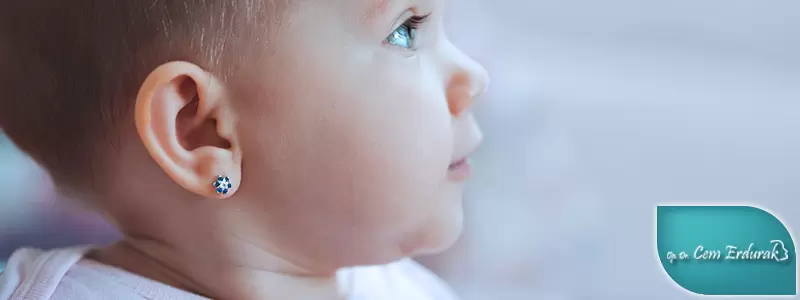
Ear piercing is generally the most ideal for painless earring wearing. However, the important thing is the location of the ear piercing. The environment must be hygienic. A healthcare facility that focuses on sterilization should be chosen. The person performing the procedure should clean the perforation area with special sterilization solutions and anesthetize the earlobe with anesthetic cream / spray. Then they should know how to control the location by injecting a small amount of anesthetic to reduce bleeding.
For piercing, the non-cartilaginous part of the ear should be preferred and the parts of the ear that are susceptible to infection should not be selected. Earrings to be used for piercing must be of least allergenic titanium material or contain 14 carat gold alloy.
Earrings should not be removed during 6 weeks following the healing period, unless there is a problem after the piercing. The punctured area should be cleaned regularly at least 2 times a day (especially after the child reaches school age), and the earring clip should be slightly rotated backwards once a day to prevent sticking. After 6 weeks, you can remove the earrings and wear other earrings if you wish.
Some minor problems can be seen in 30% of the cases during the first 1-2 weeks after ear piercing. The most common of these is wound infection. It will be useful to consult a physician if there is pain, redness, fever and yellowish discharge around the hole for earrings. On-site treatment should be performed without removing the earrings as much as possible. Another problem that occurs in children is that the earrings get stuck and pull on the earlobe during a movement (i.e. while playing). For this reason, many schools do not allow earrings to be worn or ball earrings are allowed. First of all, you should search a center for painless ear piercing.
In the past, going to a jewelry store was the first preferred method, but now pharmacies are preferred due to the desire for painless ear piercing and hygienic environment. Regardless of operation venue, the most important point is that the needle used to pierce the ear is disposable and sterile. Next, the punctured area should be kept clean to avoid contamination. Non-sterile needles and earrings can be the beginning of many dangerous diseases such as HIV, hepatitis. Therefore, care must be exercised.
Ear piercing should only be performed by professionals under proper cleaning conditions. Make sure the person who pierces your baby's ear is wearing sterile gloves, that the needle is used first by your child, and that the instruments are sterile.
Anesthetic cream applied to the earlobe can be used in pharmacies and health centers. Using ice, the earlobe can be cooled, which can reduce pain. For the first earring, those made of stainless steel can be preferred. They do not contain alloys that can cause allergies and are therefore the safest choice for first earrings. White gold earrings can be preferred at later ages as they contain nickel, which can cause allergies.
You can also get information from your doctor and the medical specialist who will act with the ear piercing procedure.
There is no specific age limit for ear piercing. As a rule, it is not recommended for children to have their ears pierced during infancy. Since there is no complete treatment during this procedure, an infection may develop in the child's ear. In addition, a child holding their ear or pulling out earrings, may encounter risks such as swallowing or itching etc. sensations. They can tear their earlobes for reasons such as playing with the ear. If you want to put earrings on your child, the best time is 10 years old.
There is a risk of infection if proper precautions are not taken during the piercing process. This begins to manifest itself as swelling, itching and redness in the ear. Inflammation may occur in the auricle. In this case, you need to seek help from a medical center. In case of infection, remove the earrings. An oral antibiotic can also be used with an antibiotic cream or doctor's recommendation. As the wound heals, the hole may close and you may need to get it pierced again. Again, you can renew the piercing process on the same location after 6 months.